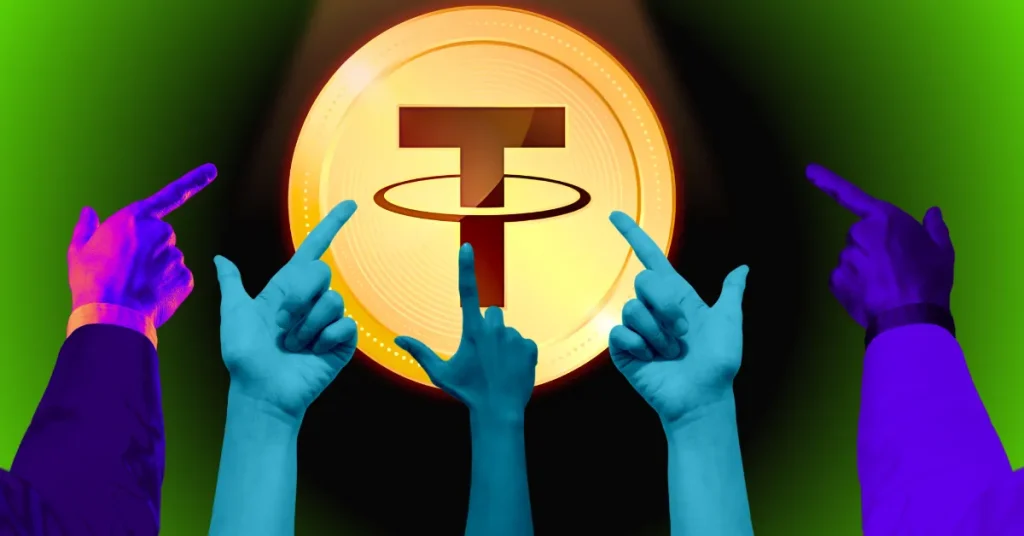2025-09-05 Friday
اخبار ارز دیجیتال
با جدیدترین اخبار و به روزرسانی های بازار ارزهای دیجیتال همراه شوید!

Abu Dhabi Grants GFO‑X Approval to Launch Digital Asset Exchange and Clearing House
The post Abu Dhabi Grants GFO‑X Approval to Launch Digital Asset Exchange and Clearing House appeared on BitcoinEthereumNews.com. Abu Dhabi Global Market (ADGM) has granted GFO‑X Group in‑principle approval to establish a digital asset exchange and clearing house, the two parties announced. The approval positions GFO‑X to offer regulated venues for trading, clearing and settlement of tokenized securities and digital assets under ADGM’s financial services framework. GFO‑X said the platform will support institutional […] Source: https://news.bitcoin.com/abu-dhabi-grants-gfo%E2%80%91x-approval-to-launch-digital-asset-exchange-and-clearing-house/
اشتراک
BitcoinEthereumNews2025/09/05 18:45
اشتراک

Naomi Osaka Upbeat After U.S. Open Semifinal Loss
The post Naomi Osaka Upbeat After U.S. Open Semifinal Loss appeared on BitcoinEthereumNews.com. NEW YORK, NEW YORK – SEPTEMBER 04: Naomi Osaka of Japan talks to the media after losing to Amanda Anisimova of the United States in the women’s singles semifinal match on Day 12 of the US Open at USTA Billie Jean King National Tennis Center on September 04, 2025 in New York City. (Photo by Robert Prange/Getty Images) Getty Images Four-time major champion Naomi Osaka said she wasn’t upset after her semifinal loss at the U.S. Open on Thursday night, adding that the experience has inspired her to improve. Osaka, the 2018 and 2020 U.S. Open champion, lost 6-7(4), 7-6(3), 6-3 to American eighth seed Amanda Anisimova, missing the chance to reach her fifth Grand Slam final. Playing in her first major semifinal since becoming a mother, Osaka made a solid start at Arthur Ashe Stadium as she took the first set but local hope Anisimova mounted a brilliant comeback to seal victory. “I’m happy that I lost in the semis instead of the first round or the third round or whatever I usually get to,” Osaka said after the match. NEW YORK, NEW YORK – SEPTEMBER 01: Naomi Osaka of Japan shows off her Labubu Althea Glitterson while talking to the media after defeating Coco Gauff of the United States in the fourth round on Day 9 of the US Open at USTA Billie Jean King National Tennis Center on September 01, 2025 in New York City (Photo by Robert Prange/Getty Images) Getty Images The 27-year-old, who took a lengthy maternity break following the birth of daughter Shai in 2023, struggled for consistency after returning to the WTA Tour last season. But this season, she has found her sparkling new form. The former world No. 1 reached the final of the ASB Classic in Auckland in the beginning of…
اشتراک
BitcoinEthereumNews2025/09/05 18:44
اشتراک

Proton Launches EV Factory Producing 20,000 Vehicles Per Year
TLDRs; Proton inaugurates Malaysia’s first EV assembly plant, aiming for 20,000 vehicles annually. The Tanjong Malim facility combines automation with trained staff, creating over 200 jobs. Partnership with China’s Geely enables local assembly of premium EV models. Malaysia strengthens its automotive leadership, staying ahead in Southeast Asia’s EV market. Malaysian automaker Proton officially opened the [...] The post Proton Launches EV Factory Producing 20,000 Vehicles Per Year appeared first on CoinCentral.
اشتراک
Coincentral2025/09/05 18:42
اشتراک

Lit Protocol’s Vincent Lets AI Agents Trade
The post Lit Protocol’s Vincent Lets AI Agents Trade appeared on BitcoinEthereumNews.com. Key Takeaways: Lit Protocol launches “Vincent” Early Access, enabling AI agents to perform real DeFi transactions under strict user-set rules. Agents can now borrow, swap, and bridge funds across major DeFi protocols like Aave, Uniswap, and deBridge without compromising key security. Vincent brings non-custodial, permissioned AI automation to production-ready status, moving DeFi agent tech beyond experimental demos. AI-powered agents are no longer a concept stuck in the lab. With the launch of Vincent Early Access, Lit Protocol introduces a new layer of secure, decentralized automation to DeFi where AI agents don’t just simulate trades, they execute real ones with verifiable control, transparency, and user-defined boundaries. Vincent: The First Practical On-chain AI Agent Framework Lit Protocol’s Vincent is a developer platform that enables autonomous, non-custodial AI agents to interact with DeFi protocols using real permissions and real assets without handing over private keys. This change may reestablish the way individuals and applications automate financial plans in a safe manner. Vincent offers instead of centralized infrastructure or bespoke bots: On-chain guardrails to enforce user-defined permissions Decentralized key management using Lit’s threshold cryptography network Composable “Abilities” and on-chain “Policies” that govern every agent action Read More: MIND of Pepe Launches AI Agent on X; Here’s Why It’s Early Crypto Launches with Promise for Real-Time Market Intelligence How It Works: Abilities, Policies & Apps Building Secure AI Agents with Vincent Vincent proposes a building blocks model of AI agents: Apps: Packages of agent and configuration developers implement. For instance, an app like Vincent Yield automatically allocates user stablecoins to high-yield pools while respecting pre-set policy limits. Abilities: Special operations that the agent is able to do (e.g., borrow on Aave, swap on Uniswap, bridge via deBridge). All abilities are versioned, composable, and require user permission to use explicitly at connect time. Policies: Rules that…
اشتراک
BitcoinEthereumNews2025/09/05 18:42
اشتراک

Musk's new compensation plan revealed: $1 trillion "bet"
PANews reported on September 5th that Tesla's board of directors proposed a new compensation plan on Friday that would reward Musk with approximately $1 trillion if he achieves a series of challenging goals over the next decade. Under the plan, Musk will not receive any salary or bonuses. Instead, his compensation will vest in installments in the form of stock, unlocked upon achieving significant growth in Tesla's market capitalization, significant increases in profitability, and key milestones such as selling millions of vehicles. In a letter to investors, board chair Robyn Denholm stated, "Retaining and motivating Elon Musk is critical to Tesla's success in becoming the most valuable company in history. This compensation plan is designed to combine extraordinary long-term shareholder value with incentives to drive peak performance from our visionary leader." The board emphasized that Musk's incentives are highly aligned with investor interests. If Tesla's growth stagnates, he will receive nothing. However, such a massive compensation package is likely to reignite the heated debate over the income level of the world's richest man.
اشتراک
PANews2025/09/05 18:38
اشتراک

Tesla's board proposes new compensation plan for Musk, saying motivating him is key to achieving goals
PANews reported on September 5th that according to Jinshi, Tesla's (TSLA.O) board of directors proposed a new compensation plan for CEO Elon Musk. Tesla (TSLA.O) stated that motivating Musk is key to achieving its goals and that it is preparing to announce its longer-term CEO compensation strategy. The board proposed establishing a special stock pool. The company is seeking to replenish the employee incentive pool by adding 60 million shares. The board also proposed authorizing an investment in Musk's artificial intelligence company, xAI. Tesla (TSLA.O) shares rose 1.5% in pre-market trading after its board proposed a new compensation plan for Musk.
اشتراک
PANews2025/09/05 18:35
اشتراک

Ethereum Whales Are Buying Top Crypto Presales Like Based Eggman $GGs and LayerBrett, Join $GGs ICO Here
The post Ethereum Whales Are Buying Top Crypto Presales Like Based Eggman $GGs and LayerBrett, Join $GGs ICO Here appeared on BitcoinEthereumNews.com. Ethereum whales often act as trendsetters in crypto, directing attention to projects before retail investors catch on. In 2025, their wallets reveal a clear interest in presale crypto tokens. These large holders are not just diversifying, they are signaling confidence in Web3 projects that combine strong communities with real utility. The current crypto presale list shows an exciting mix of cultural, gaming, and infrastructure projects. Among them, Based Eggman ($GGs) and LayerBrett stand out as two of the best crypto presales to buy right now. Both have unique approaches to community engagement and ecosystem growth, making them part of the top crypto presales gaining traction this year. Based Eggman ($GGs): Gaming, Culture, and Presale Momentum Based Eggman ($GGs) is positioning itself as more than just another coin presale. Built on Base, Coinbase’s Layer 2 solution, it merges gaming, streaming, and community-driven culture into a single Web3 hub. The token is priced at $0.006389 in its current crypto ICO presale, with over 982,000 tokens already sold and USDT raised crossing 6,200. What makes this new crypto token presale different is its cultural identity. “GGs,” shorthand for “good game,” resonates instantly with gamers and meme enthusiasts. Every match, stream, or community event inside the ecosystem rewards participants with presale crypto tokens, creating a continuous feedback loop between culture and currency. By blending nostalgic gaming themes with modern token presale mechanics, Based Eggman has placed itself firmly among the top presale crypto projects this year. It reflects how cryptocurrency presales can combine entertainment and finance while offering a straightforward entry for both traders and players. LayerBrett: The Character-Powered Layer 2 Movement LayerBrett is emerging from the crypto presale projects list as a mix of playful branding and serious blockchain development. Unlike traditional infrastructure tokens, it leans into personality and culture while still delivering…
اشتراک
BitcoinEthereumNews2025/09/05 18:35
اشتراک

Jito Foundation Sparks Excitement With Massive JTO Update
The post Jito Foundation Sparks Excitement With Massive JTO Update appeared on BitcoinEthereumNews.com. Altcoins The Jito ecosystem is entering a new phase as its foundation rolls out several initiatives designed to boost the JTO token’s long-term value. The moves include a completed $1 million buyback, a fee hike approved by governance, and new efforts to improve transparency and community engagement. First Buyback Completed Over the past 10 days, Jito executed its inaugural JTO buyback, totaling $1 million. The operation was conducted in four stages using a TWAP strategy, with plans to keep this approach in place for now. Looking ahead, the foundation revealed it is building out auction-style systems that will allow value capture to occur automatically within the protocol. Governance Shifts to JIP-24 One of the most impactful changes comes from the community’s approval of JIP-24, a proposal that raises the fee collected from the Jito Block Engine to 6%. This adjustment is expected to significantly increase inflows to the DAO’s treasury, providing greater financial backing for the project and potentially enhancing the token’s utility and value proposition. Strengthening the Ecosystem Beyond direct token economics, the Jito Foundation has also launched a dedicated JTO Economic Hub. This new portal is designed to give token holders clearer insight into how value is distributed and managed across the ecosystem. In addition, the foundation confirmed it will host the first-ever JTO holder conference on September 24, marking an effort to bring the community closer to the protocol’s long-term vision. What It Means for JTO Taken together, these updates reflect an ecosystem aiming to mature both financially and organizationally. By combining treasury growth with new communication tools and community events, Jito is signaling its commitment to making JTO more than just a governance token—it’s positioning it as a central pillar of the network’s sustainability. The information provided in this article is for informational purposes only and…
اشتراک
BitcoinEthereumNews2025/09/05 18:32
اشتراک

UX is the killer app for mass adoption in web3
The post UX is the killer app for mass adoption in web3 appeared on BitcoinEthereumNews.com. Disclosure: The views and opinions expressed here belong solely to the author and do not represent the views and opinions of crypto.news’ editorial. When FTX collapsed in 2022, it didn’t just vaporize billions of dollars in customer funds; the exchange’s implosion shattered confidence in the centralized architecture in much of the crypto economy. And with court battles still ongoing in 2025, including plans to return $1.9 billion in disputed claims, it’s a reminder that trusting middlemen in a trustless ecosystem can be a risky contradiction. Summary The self-custody market is surging post-FTX, projected to grow from $1.5B in 2023 to $8.4B by 2032, driven by both institutions and retail users. On-chain data shows users shifting from centralized exchanges to DEXs, with spot volumes falling 16.3% while DEX activity rose 6.2% in early 2025. UX remains the industry’s bottleneck — wallets and dApps often confuse users with jargon, poor recovery, and hidden centralization. Fiat-to-crypto on-ramps are crypto’s front door; smooth, compliant rails are essential for adoption and trust. The next 100M users will come not from new protocols but from an intuitive, safe, and invisible design that makes web3 feel seamless. In the aftermath of FTX’s collapse in 2023, the self-custody market was already worth $1.5 billion and projected to hit $8.4 billion by 2032. This wasn’t just a temporary response to the crisis; it signaled a deeper shift in people’s mindset. Users wanted tools that put them in control. It is perhaps no surprise that users are seeking to reclaim control. Many have moved their assets to non-custodial wallets, seeking safety in their own personal responsibility where they can hold their own keys and shoulder their own risk. The numbers behind a behavioural shift Spot trading volume at the top ten centralized exchanges decreased by 16.3% quarter-on-quarter from $6.5 trillion…
اشتراک
BitcoinEthereumNews2025/09/05 18:31
اشتراک

Tether Expands into Gold Industry
The post Tether Expands into Gold Industry appeared first on Coinpedia Fintech News Tether is planning to expand its gold investments beyond holding $8.7 billion in gold bars. The company aims to invest in gold mining, refining, trading, and royalty businesses to strengthen its backing and diversify its assets. In June, Tether bought a $105 million stake in the Toronto-listed Elemental Altus royalty company and recently added $100 …
اشتراک
CoinPedia2025/09/05 18:29
اشتراک